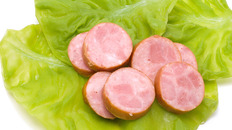Meats and Sausages
Krakowska Sausage (Kielbasa krakowska krajana)
This sausage has always been one of the top sellers in Poland. The name relates to the city of Krakow, one of the oldest cities in Europe. The middle part of the name “krajana” implies that the meat was manually cut into pieces. It goes by many similar names for example Krakauer Sausage.
| Meats | Metric | US |
|---|---|---|
| lean pork, ham or butt | 900 g | 1.98 lb. |
| pork jowls or fatty pork trimmings, picnic meat | 100 g | 0.22 lb. |
Ingredients per 1000g (1 kg) of meat
| salt | 18 g | 3 tsp. |
| Cure #1 | 2.5 g | ½ tsp. |
| white pepper | 2.0 g | 1 tsp. |
| nutmeg | 1.0 g | ½ tsp. |
| cold water | 30 ml | 2 Tbsp. |
Instructions
- Manually cut lean pork into 1” (25 mm) cubes. Grind fat pork through ⅛” (3 mm) plate. Keep meats separate.
- Grind fat pork again adding cold water and all remaining ingredients or emulsify in food processor.
- Mix diced pork with emulsified mixture well together.
- Stuff firmly into 75 mm (3”) hog middles or synthetic fibrous casings. Stuff casings firmly and tie up both ends. Form 16-18” long sections. Prick any visible air pockets with a needle
- Hang at room temperature for 2 hours.
- Smoking/Cooking is done in three steps:
- Dry sausages using thin smoke, 113-131°F (45-55°C) for 20 min.
- Smoke with a thick smoke, 113-131°F (45-55°C) for 150 min.
- Bake with a thin smoke, 167-194°F (75-90°C) for 20-30 min.
- Total time about 3 hours until the internal meat temperature reaches (154-158°F) 68-70°C and casings are dark brown.
- Shower with cold water for about 5 min and place in refrigerator.
Notes
For best results and visual presentation cure lean pork (or all meats) traditionally. Cut meats into 1" (25 mm) cubes, mix with salt and cure #1, pack tightly into a container, cover with a clean cloth and hold in refrigerator for 48 hours. Keep fat meat separately as it will be emulsified.


















